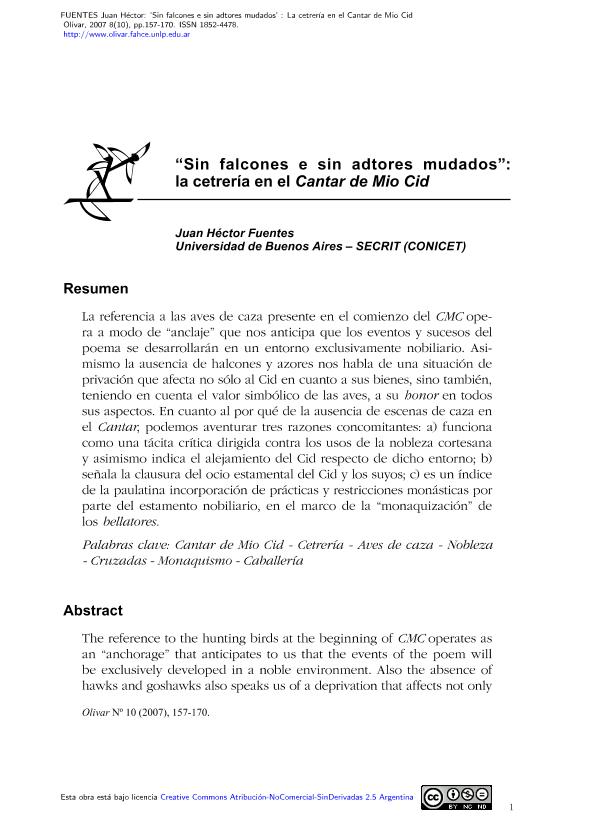Mostrar el registro sencillo del ítem
dc.contributor.author
Fuentes, Juan Héctor

dc.date.available
2020-07-31T20:16:12Z
dc.date.issued
2007-12
dc.identifier.citation
Fuentes, Juan Héctor; "Sin falcones e sin adtores mudados": La cetrería en el Cantar de Mio Cid; Universidad Nacional de La Plata. Facultad de Humanidades y Ciencias de la Educación; Olivar; 8; 10; 12-2007; 157-170
dc.identifier.issn
1515-1115
dc.identifier.uri
http://hdl.handle.net/11336/110687
dc.description.abstract
La referencia a las aves de caza presente en el comienzo del CMC opera a modo de "anclaje" que nos anticipa que los eventos y sucesos del poema se desarrollarán en un entorno exclusivamente nobiliario. Asimismo la ausencia de halcones y azores nos habla de una situación de privación que afecta no sólo al Cid en cuanto a sus bienes, sino también, teniendo en cuenta el valor simbólico de las aves, a su honor en todos sus aspectos. En cuanto al por qué de la ausencia de escenas de caza en el Cantar, podemos aventurar tres razones concomitantes: a) funciona como una tácita crítica dirigida contra los usos de la nobleza cortesana y asimismo indica el alejamiento del Cid respecto de dicho entorno; b) señala la clausura del ocio estamental del Cid y los suyos; c) es un índice de la paulatina incorporación de prácticas y restricciones monásticas por parte del estamento nobiliario, en el marco de la "monaquización" de los bellatores.
dc.description.abstract
The reference to the hunting birds at the beginning of CMC operates as an "anchorage" that anticipates to us that the events of the poem will be exclusively developed in a noble environment. Also the absence of hawks and goshawks also speaks us of a deprivation that affects not only to the Cid as far as its possessions, but, considering the symbolic value of the birds, to his honour in all its aspects. About the absence of hunting scenes in the Cantar, we can venture three concomitant reasons: a) it works as a tacit critic directed against the uses of the court and also would indicate the distance of the Cid respect to this environment; b) it indicates the closing of the class leisure of the Cid and his men; c) it is a sign of the gradual incorporation of monastic practices and restrictions by the noble class, within the framework of the "monastization" of bellatores.
dc.format
application/pdf
dc.language.iso
spa
dc.publisher
Universidad Nacional de La Plata. Facultad de Humanidades y Ciencias de la Educación

dc.rights
info:eu-repo/semantics/openAccess
dc.rights.uri
https://creativecommons.org/licenses/by-nc-nd/2.5/ar/
dc.subject
CANTAR DE MIO CID
dc.subject
CETRERÍA
dc.subject
AVES DE CAZA
dc.subject
NOBLEZA
dc.subject
CRUZADAS
dc.subject
MONAQUISMO
dc.subject
CABALLERÍA
dc.subject.classification
Estudios Generales de Literatura

dc.subject.classification
Lengua y Literatura

dc.subject.classification
HUMANIDADES

dc.title
"Sin falcones e sin adtores mudados": La cetrería en el Cantar de Mio Cid
dc.type
info:eu-repo/semantics/article
dc.type
info:ar-repo/semantics/artículo
dc.type
info:eu-repo/semantics/publishedVersion
dc.date.updated
2020-07-21T20:23:49Z
dc.journal.volume
8
dc.journal.number
10
dc.journal.pagination
157-170
dc.journal.pais
Argentina

dc.journal.ciudad
La Plata
dc.description.fil
Fil: Fuentes, Juan Héctor. Consejo Nacional de Investigaciones Científicas y Técnicas. Seminario de Edición y Crítica Textual "Germán Orduna"; Argentina. Universidad de Buenos Aires; Argentina
dc.journal.title
Olivar
dc.relation.alternativeid
info:eu-repo/semantics/altIdentifier/url/https://www.olivar.fahce.unlp.edu.ar/article/view/OLIv08n10a09
dc.relation.alternativeid
info:eu-repo/semantics/altIdentifier/url/https://dialnet.unirioja.es/servlet/articulo?codigo=2592402
Archivos asociados
